Thursday, December 22, 2016
10 Best Android Apps You Should Download
Making Money with Your Website
Friday, December 9, 2016
10 easy ways to make money online and live your life like a boss
Thursday, November 17, 2016
Top 10 Technology Trends for 2016
The Device Mesh
The device mesh moves beyond the traditional desktop computer and mobile devices (tablets and smartphones) to encompass the full range of endpoints with which humans might interact. As the device mesh evolves, Gartner expects connection models to expand and greater cooperative interaction between devices to emerge. We will see significant development in wearables and augmented reality, especially in virtual reality.
2: Ambient User Experience
All of our digital interactions can become synchronized into a continuous and ambient digital experience that preserves our experience across traditional boundaries of devices, time and space. The experience blends physical, virtual and electronic environments, and uses real-time contextual information as the ambient environment changes or as the user moves from one place to another.
Organizations will need to consider their customers’ behavior journeys to shift the focus on design from discrete apps to the entire mesh of products and services involved in the user experience.
3: 3D-Printing Materials
We’ll see continued advances in 3D printing with a wide range of materials, including advanced nickel alloys, carbon fiber, glass, conductive ink, electronics, pharmaceuticals and biological materials for practical applications expanding into aerospace, medical, automotive, energy and the military.
Recent advances make it possible to mix multiple materials together with traditional 3D printing in one build. This could be useful for field operations or repairs when a specific tool is required and printed on demand. Biological 3D printing — such as the printing of skin and organs — is progressing from theory to reality; however, politicians and the public don’t have a full understanding of the implications.
4: Information of Everything
Everything surrounding us in the digital mesh is producing, using and communicating with virtually unmeasurable amounts of information. Organizations must learn how to identify what information provides strategic value, how to access data from different sources, and explore how algorithms leverage Information of Everything to fuel new business designs.
5: Advanced Machine Learning
Advanced machine learning is what makes smart machines appear “intelligent” by enabling them to both understand concepts in the environment, and also to learn. Through machine learning a smart machine can change its future behavior. This area is evolving quickly, and organizations must assess how they can apply these technologies to gain competitive advantage.
6: Autonomous Agents and Things
Advanced machine learning gives rise to a spectrum of smart machine implementations — including robots, autonomous vehicles, virtual personal assistants (VPAs) and smart advisors — that act in an autonomous (or at least semiautonomous) manner. This feeds into the ambient user experience in which an autonomous agent becomes the main user interface. Instead of interacting with menus, forms and buttons on a smartphone, the user speaks to an app, which is really an intelligent agent.
7: Adaptive Security Architecture
The complexities of digital business and the algorithmic economy, combined with an emerging “hacker industry,” significantly increase the threat surface for an organization. IT leaders must focus on detecting and responding to threats, as well as more traditional blocking and other measures to prevent attacks.
8: Advanced System Architecture
The digital mesh and smart machines require intense computing architecture demands to make them viable for organizations. They’ll get this added boost from ultra-efficient-neuromorphic architectures. Systems built on graphics processing units (GPUs) and field-programmable gate-arrays (FPGAs) will function more like human brains that are particularly suited to be applied to deep learning and other pattern-matching algorithms that smart machines use. FPGA-based architecture will allow distribution with less power into the tiniest Internet of Things (IoT) endpoints, such as homes, cars, wristwatches and even human beings.
9: Mesh App and Service Architecture
The mesh app and service architecture are what enable delivery of apps and services to the flexible and dynamic environment of the digital mesh. This architecture will serve users’ requirements as they vary over time. It brings together the many information sources, devices, apps, services and microservices into a flexible architecture in which apps extend across multiple endpoint devices and can coordinate with one another to produce a continuous digital experience.
10: Internet of Things Architecture and Platforms
IoT platforms exist behind the mesh app and service architecture. The technologies and standards in the IoT platform form a base set of capabilities for communicating, controlling, managing and securing endpoints in the IoT. The platforms aggregate data from endpoints behind the scenes from an architectural and a technology standpoint to make the IoT a reality.
Tuesday, November 15, 2016
Top 10 fastest-growing tech skills in IT industry
1. Spark
Following the success of its open-source framework, Hadoop, Apache developed this open-source processing engine aimed at helping companies process large data sets. With more companies building out their tech infrastructures, Spark professionals with strong coding and programming skills are top hiring priorities, says Bob Melk, president of Dice. In addition to competitive compensation packages, hiring managers on Dice are offering professional development and leadership opportunities to entice candidates with Spark expertise to join their team, Melk says.
2. Azure
Microsoft Azure is a cloud computing platform designed to improve productivity for tech professionals. Azure is a crucial skill to have, as it can help streamline and simplify mobile app development or analytics, says Melk. Professionals with experience in Microsoft Azure and Amazon Web Services (AWS) are particularly marketable, with hiring managers on Dice often looking for candidates who possess both of those skillsets, he says.
3. Salesforce
Salesforce is far from new in the technology world, but it is new to Dice's fastest-growing skills list. Salesforce continues to be a dominant player, offering innovative customer service services for sales teams looking to drive leads and foster stronger client relationships. Interest in Salesforce professionals is widespread, with universities, management consulting firms and insurance companies all looking for professionals with this skillset on Dice, says Melk.
4. Big Data
Big data is an all-encompassing term for any collection of data sets so large and complex that it becomes difficult to process them using traditional data processing applications. Companies today that are looking for a competitive edge to leverage big data to gain insight into customer behavior or patterns in users, making this a highly in-demand skill, says Melk.
5. JIRA
JIRA is a bug, issue-tracking, and project management system developed by Atlassian and commonly used in software development. JIRA has garnered popularity in the tech world, with more and more hiring managers on Dice citing JIRA as a mandatory prerequisite rather than just a "nice-to-have" skill for a position in software development, Melk says.
6. Electrical Engineer
Though it's the only engineering position on the list, it's no surprise electrical engineers are in huge demand, says Melk. The role deals with the design, programming, application, manufacturing and operation of electronic or computer systems, and play a huge role in the design and development of Internet-of-Things (IoT) technology; though these professionals can work for a wide variety of employers from government contractors to large tech firms and startups
7. Cloud
As more companies adopt cloud technology as a solution for storage and data access, as well as cloud-based applications and technology providers, cloud skillsets are in high demand, Melk says. Cloud-based applications are popping up across a variety of industries and the technology is as ubiquitous today as mobile or big data. For that reason, companies are more than willing to open up their wallets for candidates with cloud expertise, Melk says
8. Hive
Apache Hive is a data warehouse system that analyzes large Hadoop data sets. Hive's popularity is growing in tandem with other big data skills, like Spark and more general big data and data analytics skills, says Melk. While still new to the market, this big data tool is continuing to garner recognition, with companies like Apple and Amazon looking for professionals with a working knowledge of Hive.
9. Cassandra
Cassandra is another big data/Apache skill that's also used to help store, process and access large sets of data. Essential to a company's success, professionals with Cassandra experience are well-compensated.
10. Juniper
In today's market, most companies rely on specific networking products and services to drive their success, including vendors such as juniper networks , which provides provides companies with network-based identity and policy control products and firewalls. Melk says Dice often sees hiring managers in the market for candidates with vendor-specific network administration or security or support roles, especially around Juniper Networks technology.
Wednesday, November 9, 2016
Top 10 Password Management Apps To Keep Your Digital Life safe and Secured
1. Password (Free)
 One of the most well known names in the business, 1Password makes it simple to store usernames and passwords, as well as credit card information, addresses and even simple notes. It’ll easily generate new passwords for you before filling websites with the information in a couple of taps. A pro service offers additional categories such as bank accounts, and driver’s licenses, for a fee.
One of the most well known names in the business, 1Password makes it simple to store usernames and passwords, as well as credit card information, addresses and even simple notes. It’ll easily generate new passwords for you before filling websites with the information in a couple of taps. A pro service offers additional categories such as bank accounts, and driver’s licenses, for a fee.
2. LastPass (Free)
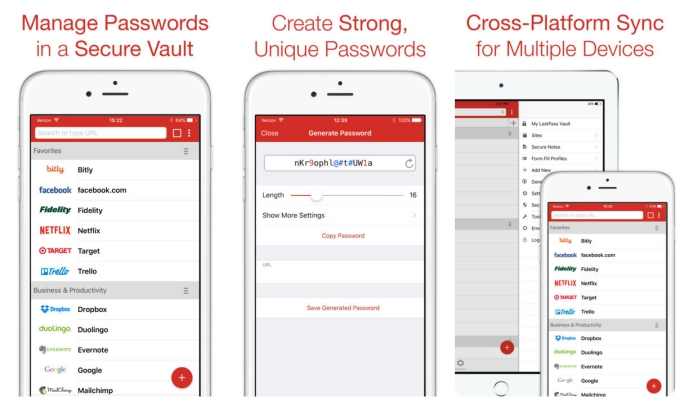 LastPass simply requires you to remember one password, before doing the rest for you, automatically filling in your logins, and even allowing you to sign in via TouchID. Offering a place to store membership details, IDs, software keys and pretty much everything else you want to keep private, the app is a Swiss Army Knife of security features. It’ll even give you a heads up when other sites or services have been hacked, reminding you to be extra vigilant.
LastPass simply requires you to remember one password, before doing the rest for you, automatically filling in your logins, and even allowing you to sign in via TouchID. Offering a place to store membership details, IDs, software keys and pretty much everything else you want to keep private, the app is a Swiss Army Knife of security features. It’ll even give you a heads up when other sites or services have been hacked, reminding you to be extra vigilant.
3. SplashID (Free)
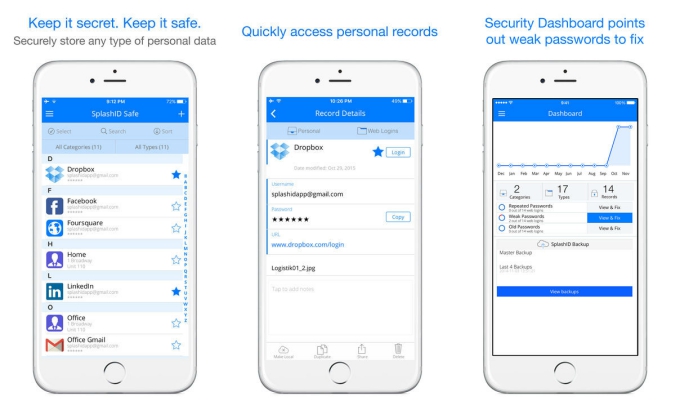 SplashID is a well established password storage system, providing a place for all your secure data. With a choice of cloud syncing or Wi-Fi syncing, you can be in complete control. Secure sharing also means you can share content with other SplashID users, plus there are attachment options and a photo capturing service.
SplashID is a well established password storage system, providing a place for all your secure data. With a choice of cloud syncing or Wi-Fi syncing, you can be in complete control. Secure sharing also means you can share content with other SplashID users, plus there are attachment options and a photo capturing service.
4. Dashlane (Free)
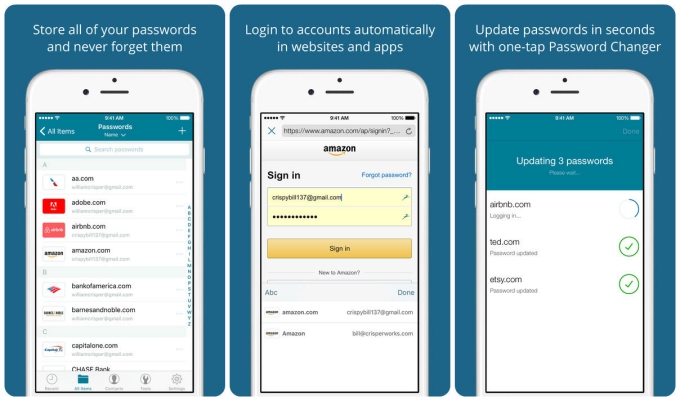 Dashlane offers a stylish interface while keeping your passwords secure. It syncs across all devices easily, while encrypting your data at all times. Autofill login makes browsing different sites a breeze, while still allowing you to use highly complex passwords. An auto-lock feature keeps things safe even if you lose your iOS device, too.
Dashlane offers a stylish interface while keeping your passwords secure. It syncs across all devices easily, while encrypting your data at all times. Autofill login makes browsing different sites a breeze, while still allowing you to use highly complex passwords. An auto-lock feature keeps things safe even if you lose your iOS device, too.
5. mSecure Password Manager ($9.99) Offering a one time price rather than requiring a subscription, mSecure Password Manager provides the typical features of password generation and 256bit encryption. An auto-backup reminder keeps on top of things, while a series of templates makes it super easy to enter new data and information.
Offering a one time price rather than requiring a subscription, mSecure Password Manager provides the typical features of password generation and 256bit encryption. An auto-backup reminder keeps on top of things, while a series of templates makes it super easy to enter new data and information.
6. Enpass Password Manager (Free) Available on multiple platforms, Enpass Password Manager embraces TouchID making it easy to unlock your content at a tap of your finger. No subscription is required with a number of preset templates ensuring your data is easy to enter, before being kept secure. Folder support makes it a breeze to navigate too.
Available on multiple platforms, Enpass Password Manager embraces TouchID making it easy to unlock your content at a tap of your finger. No subscription is required with a number of preset templates ensuring your data is easy to enter, before being kept secure. Folder support makes it a breeze to navigate too.
7. PasswordWallet ($4.99)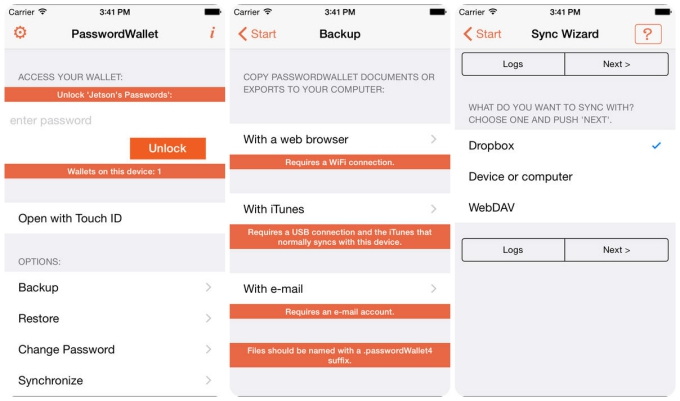 PasswordWallet prides itself on the fact you don’t require iTunes or any special software to easily backup, restore, and view your data on any PC, while also managing your passwords. It’ll easily sync up with PC or Mac, as well as work across multiple files and computers, being a particular advantage to more complex needs.
PasswordWallet prides itself on the fact you don’t require iTunes or any special software to easily backup, restore, and view your data on any PC, while also managing your passwords. It’ll easily sync up with PC or Mac, as well as work across multiple files and computers, being a particular advantage to more complex needs.
8. Keeper (Free)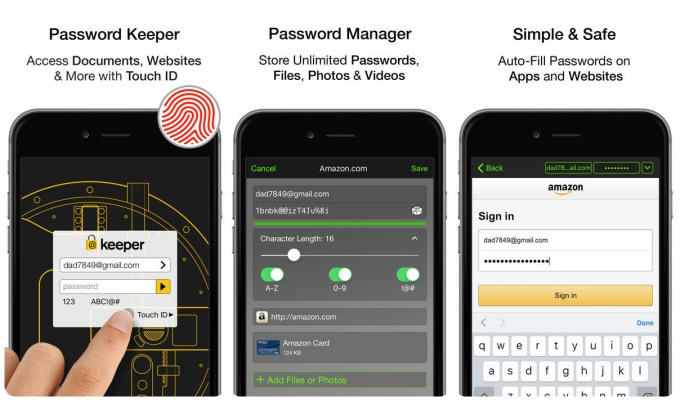 Keeper takes seconds to set up, storing unlimited number of passwords, only accessible via your fingerprint. It’ll generate new ones, as well as auto-fill content in apps and websites. You can store files, photos and videos within a private vault, ensuring everything on your phone is safely tucked away. Two-step verification can also be set up for added security.
Keeper takes seconds to set up, storing unlimited number of passwords, only accessible via your fingerprint. It’ll generate new ones, as well as auto-fill content in apps and websites. You can store files, photos and videos within a private vault, ensuring everything on your phone is safely tucked away. Two-step verification can also be set up for added security.
9. eWallet ($9.99) eWallet offers a place to store your passwords, credit cards, and bank account numbers all behind high end encryption. A password generator is included, along with an auto-locking feature, TouchID support, and extensive syncing functionality. It’s optimized for the iPad too, providing multitasking support for added ease.
eWallet offers a place to store your passwords, credit cards, and bank account numbers all behind high end encryption. A password generator is included, along with an auto-locking feature, TouchID support, and extensive syncing functionality. It’s optimized for the iPad too, providing multitasking support for added ease.
10. DataVault Password Manager ($9.99)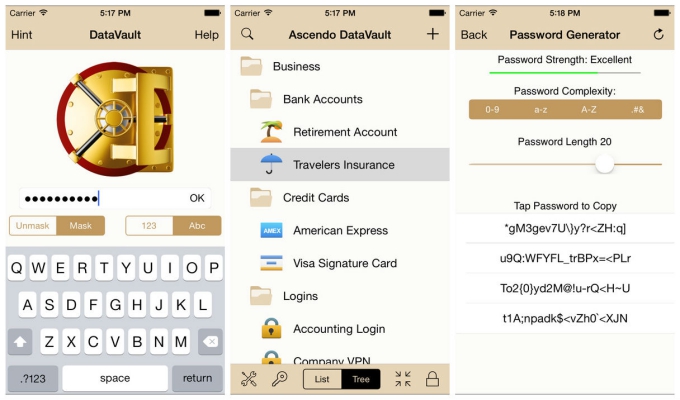 A well known name in the field, DataVault might look dated but it’s pretty powerful. The app offers AES encryption, Touch ID support, iCloud syncing, and automatic backups. It’s possible to set it up so everything is wiped after too many incorrect login attempts, but there’s always the option of a hint too. A series of templates makes it ideal for multiple forms of data.
A well known name in the field, DataVault might look dated but it’s pretty powerful. The app offers AES encryption, Touch ID support, iCloud syncing, and automatic backups. It’s possible to set it up so everything is wiped after too many incorrect login attempts, but there’s always the option of a hint too. A series of templates makes it ideal for multiple forms of data.
Tuesday, November 8, 2016
Top 10 highest paying IT security jobs In world
1.Lead Software Security Engineer
Lead software security engineers are tasked with doing everything from maintaining and deploying employee training programme to developing security related aspects of application programme. Lead software security engineers should have at least a BS in computer science or a similar field with relevant security certifications. And soft skills, like communications and collaboration skills also are critical.
2.Chief security officer (CSO)
Chief security officers prepare organisations to counter existing and emerging threats. These CD suite professionals are responsible for establishing and communicating best practice for maintaining data security, as well as monitoring the effectiveness of security operations. This role often requires certifications in addition to at least a BS degree in computer science or a similar field.
3.Global information security director
This role involves the maintenance and execution of information security projects and coordinating the response to a breach or an attack if one occurs. The global information security director may be required to have a working knowledge of industry-specific rules and regulations -- such as HIPAA in healthcare or FISMA in the finance industry -- in addition to at least a BS in computer science and extensive security certifications.
4.Director of security
Directors of security can have varying roles and responsibilities based on their organization, with most of their energy centered on minimizing the risk of attack while guiding internal teams in maintaining proper security procedures. Since the director of security will need to interact with employees as well as external vendors and partners, good soft skills are a must.
5.Chief information security officer (CISO)
This role is similar to that of the chief security officer, but focuses more intently on protecting an organization's data and intellectual property -- the information-related assets. CISO responsibilities typically include maintaining best practices and designing effective policies to handle breaches and other disasters.
6.IT security consultant
Security consultants work with clients to develop strategies for effective cybersecurity across their entire organization. In addition to knowing best practices and recommended procedures, they must also possess solid communication, negotiation and project management skills. Organizations look for consultants with multiple years of experience, as well as a working knowledge of industry rules, regulations and broad and deep knowledge of enterprise security vendors and products.
7.Lead security engineer
Lead security engineers can be tasked with many different responsibilities, depending on their organization: securing operating environments, telephony and video conference systems as well as software, hardware and information (both stored and while in transit). The job does have some constants; typically these include reviewing code and procedures to detect security vulnerabilities, spreading awareness of those potential vulnerabilities to employees and implementing security tools to protect the organization.
8.Cybersecurity lead
A cybersecurity lead has a particularly demanding and high-pressure job: evaluating the organization for potential vulnerabilities in conjunction with analysts and other security staff, detecting any attacks underway and informing management.
9.Cybersecurity engineer
Cybersecurity engineers typically are experienced in penetration testing and other cybersecurity tools, and use them to keep an organization secure against both internal and external threats. Many jobs require certifications in addition to at least a BS in a technical field, along with some actual on-the-job experience.
10.Application security manager
Application security managers are in charge of ensuring any applications produced or used by their organization meet minimum standards for security and privacy. This role often reports to a Director of Security or similar management position.
Tuesday, November 1, 2016
Top 15 best technology news websites
1.Centernetworks – The site offers news, reviews, insights and interviews covering Web 2.0, social networking, social media and social lending with a special focus on Web applications development.
2. Cnet.com – If Engadget cool, albeit geeky, way of presenting fresh tech news doesn’t appeal to you (see below), then you may like Cent's more business oriented writing. Like Engadget, Cnet.com also has a stable of reliable news sources, which helps the site break news and exclusives.
3.Crave – Crave commentaries on the gadget world are top notch, well written and occasionally witty.
4.CrunchGear – It’s your daily dose of geek gadgets: cell phones, gaming hardware, software, computers. Techcrunch gadget arm competes with Engadget in the gadget news and reviews arena.
5.DailyTech – This is an online magazine geared for the well-educated tech audience. It features hard hitting and up-to-the-minute tech news.
6.Download Squad – With a diverse crew of tech writers, Download Squad offers the latest news and reviews of downloadable applications on Windows, Mac, Linux and mobile devices.
7.NYT Technology Bits – This online newspaper’s technology content is not to be outdone with its timely and will-written tech news.
8.Official Google Blog – The search engine behemoth’s official blog deserves to be on our list: it is the official source for all things Google – products, services, acquisitions and more.
9.PCWorld – The online version of the popular magazine offers quick access to authoritative reviews of technology products, pricing information, updated tech news and downloads of freeware and shareware. It reigns as one of the industry’s best news sites.
10.ReadWriteWeb – This is another premiere Web 2.0, social media and startup centric site. It has distinguished itself from the rest of the crowd with its comprehensive and well written articles on Web applications, Web technology trends, social networking sites, social media applications.
11.Scobleizer – Robert Scoble comments on tech news, blogging and the Internet. Chances are if you read a post or two, you’ll come back.
12.Techcrunch – Who doesn’t know the blogosphere’s top tech blog? If you’re a blogger and into tech related stuff, Techcrunch is your ultimate source for anything and everything on startups, Web 2.0, social networking and VCs. The site always breaks interesting news and offers exclusive coverage. TC news items range from the simple to the most comprehensive.
13.TechRepublic.com – This is another well crafted and professional source for business and technology news. The site features timely articles, forums, multimedia and other technology related information products.
14.TechSpot – Since opening its doors in 1998, Techspot has evolved into one of the leading independent computer technology sites for computer enthusiasts, gamers and IT professionals. The site provides daily news coverage, in depth product reviews, buying guides and download updates.
15.The Inquirer – The site offers the latest breaking news on computers, mobile devices, servers, consoles, hardware and software innovation, graphics and microprocessors.
Thursday, October 27, 2016
Paperless tools in digital worlds
Top Paperless tools in digital worlds

Wednesday, October 26, 2016
Top 5 ways to be a better programmer in 2016
Coders make resolutions, no? If your to-do better list is still empty, consider these ideas from other programmers to put to use in the new year. Even the smartest folks have room to grow.
Great tips to help you sharpen your programming skills.
1. Check Your Code First Before Looking to Blame Others
Question your own assumptions and the assumptions of others. Tools from different vendors might have different assumptions built into them so too might different tools from the same vendor.
When someone else is reporting a problem you cannot duplicate, go and see what they are doing. They may be doing something you never thought of or are doing something in a different order.
My personal rule is that if I have a bug I can’t pin down, and I’m starting to think it’s the compiler, then it’s time to look for stack corruption. This is especially true if adding trace code makes the problem move around. Multi threaded problems are another source of bugs that turn hair gary and induce screaming at the machine. All the recommendations to favor simple code are multiplied when a system is multi threaded. Debugging and unit tests cannot be relied on to find such bugs with any consistency, so simplicity of design is paramount
2. Continuous Learnig
Read books, magazines, blogs, Twitter feeds, and websites. If you want to go deeper into a subject, consider joining a mailing list or newsgroup.
If you really want to get immersed in a technology, get hands on—write some code.Always try to work with a mentor, as being the top guy can hinder your education. Although you can learn something from anybody, you can learn a whole lot more from someone smarter or more experienced than you. If you can’t find a mentor, consider moving on.Use virtual mentors. Find authors and developers on the Web who you really like and read everything they write. Subscribe to their blogs.Get to know the frameworks and libraries you use. Knowing how something works makes you know how to use it better. If they’re open source, you’re really in luck. Use the debugger to step through the code to see what’s going on under the hood. You’ll get to see code written and reviewed by some really smart people
3. Don’t Be Afraid to Break Things
Don’t be afraid of your code. Who cares if something gets temporarily broken while you move things around? A paralyzing fear of change is what got your project into this state to begin with. Investing the time to refactor will pay for itself several times over the lifecycle of your project. An added benefit is that your team’s experience dealing with the sick system makes you all experts in knowing how it should work. Apply this knowledge rather than resent it. Working on a system you hate is not how anybody should have to spend his time. Redefine internal interfaces, restructure modules, refactor copy-pasted code, and simplify your design by reducing dependencies. You can significantly reduce code complexity by eliminating corner cases, which often result from improperly coupled features. Slowly transition the old structure into the new one, testing along the way. Trying to accomplish a large refactor in “one big shebang” will cause enough problems to make you consider abandoning the whole effort midway through.
4. The Professional Programmer
The single most important trait of a professional programmer is personal responsibility. Professional programmers take responsibility for their career, their estimates, their schedule commitments, their mistakes, and their workmanship. A professional programmer does not pass that responsibility off on others.
If you are a professional, then you are responsible for your own career. You are responsible for reading and learning. You are responsible for staying up to date with the industry and the technology. Too many programmers feel that it is their employer’s job to train them. Sorry, this is just dead wrong. Do you think doctors behave that way? Do you think lawyers behave that way? No, they train themselves on their own time, and their own nickel. They spend much of their off-hours reading journals and decisions. They keep themselves up to date. And so must we. The relationship between you and your employer is spelled out nicely in your employment contract. In short: your employer promises to pay you, and you promise to do a good job.
5. Take Advantage of Code Analysis Tools
The value of testing is something that is drummed into software developers from the early stages of their programming journey. In recent years, the rise of unit testing, test-driven development, and agile methods has attested to a surge of interest in making the most of testing throughout all phases of the development cycle. However, testing is just one of many tools that you can use to improve the quality of code.
Back in the mists of time, when C was still a new phenomenon, CPU time and storage of any kind were at a premium. The first C compilers were mindful of this and so cut down on the number of passes through the code they made by removing some semantic analyses. This meant that the compiler checked for only a small subset of the bugs that could be detected at compile time. To compensate, Stephen Johnson wrote a tool called lint—which removes the fluff from your code—that implemented some of the static analyses that had been removed from its sister C compiler. Static analysis tools, however, gained a reputation for giving large numbers of false-positive warnings and warnings about stylistic conventions that aren’t always necessary to follow.
The current landscape of languages, compilers, and static analysis tools is very different. Memory and CPU time are now relatively cheap, so compilers can afford to check for more errors. Almost every language boasts at least one tool that checks for violations of style guides, common gotchas, and sometimes cunning errors that can be hard to catch, such as potential null pointer dereferences. The more sophisticated tools, such as Splint for C or Pylint for Python, are configurable, meaning that you can choose which errors and warnings the tool emits with a configuration file, via command-line switches, or in your IDE. Splint will even let you annotate your code in comments to give it better hints about how your program works.
5 Important Google Links
The 5 Important Google Links
Google stores everything privately and here are the 10 important links (URLs) that will unlock everything Google knows about you. They are hidden somewhere deep inside your Google Account dashboard and they may reveal interesting details about you that are otherwise only known to Google. Let’s dive in.
1. Google stores a list of usernames and passwords that you have typed in Google Chrome or Android for logging into various websites. They even have a website too where you can view all these passwords in plain text.
2. Google creates a profile of yourself based on the sites you visit, guessing your age, gender and interests and then use this data to serve you more relevant ads. Use this URL to know how Google sees you on the web.
3. You can easily export all your data out of the Google ecosystem. You can download your Google Photos, contacts, Gmail messages and even your YouTube videos. Head over the the Takeout page to grab the download links.
4. If you ever find your content appearing on another website, you can raise a DMCA complaint with Google against that site to get the content removed. Google has a simple wizard to help you claim content and the tool can also be used to remove websites from Google search results that are scraping your content.
5. Your Android phone or the Google Maps app on your iPhone is silently reporting your location and velocity (are you moving and if yes, how fast are you moving) back to Google servers. You can find the entire location history on the Google Maps website and you also have the option to export this data as KML files that can be viewed inside Google Earth or even Google Drive.
Some facts on blogs that make money
Some facts on blogs that make money
Blogging has moved from the tech geeks domain to “new media”. It is now cool and can be very lucrative. Before we dive in here are some interesting facts about some blogs that make serious money.
Post free ads on
99localads.com
Tuesday, October 25, 2016
Top 15 classified websites of 2016
List of top 15 classifieds of 2016
If you dont agree with the list then ad your site in comments and i will update the list of top 10 classifieds.
1. Quikr.com
2. Olx.in
3. craigslist.org
4. click.in
5. 99localads. Com
6. locanto.in
7. Sulekha.com
8. vivastreet.co.in
9. indialist.com
10. khojle.in
Other sites which are popular as well :
Another 5 classifieds websites that are as well quite popular in India
11. Adeex.com
12. freeads.in
13. clickindia.com
14. Justdoondo.com
15. adsglobe.com

